The Best Deals on Camping, Backpacking and Outdoor Gear [June 2025]
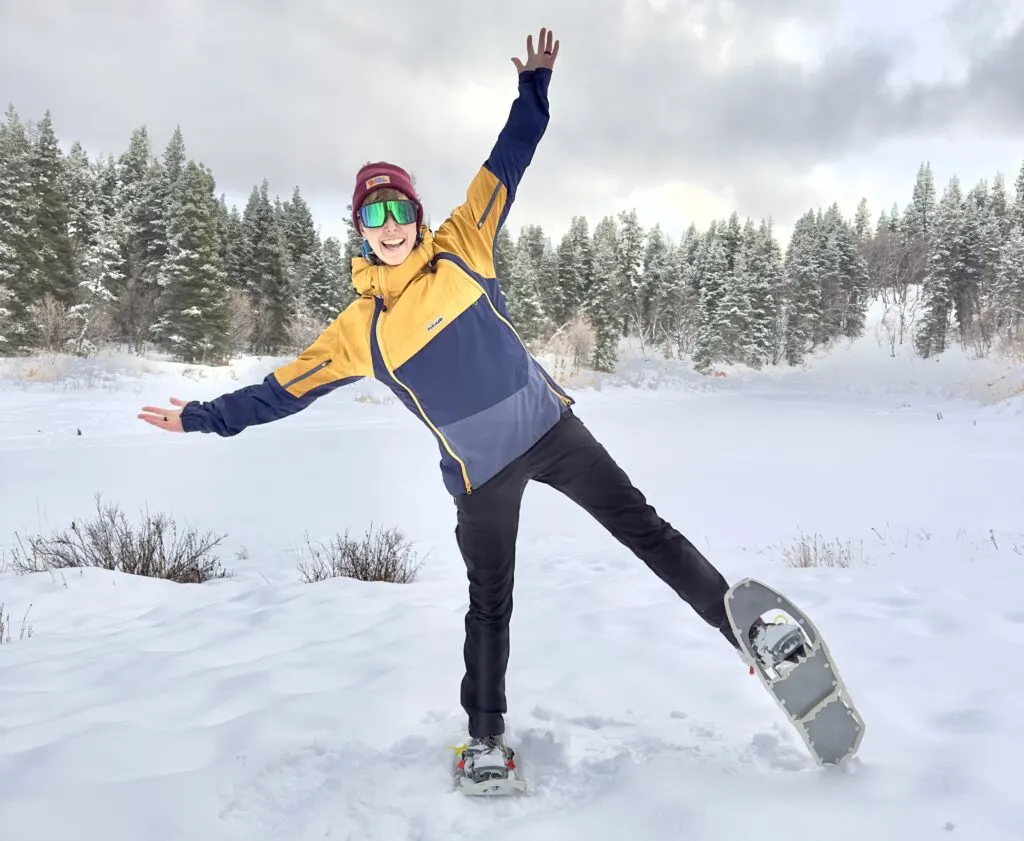
Snowshoes. We love ’em. They allow us to get outside and blaze trails all winter long, no matter how much white powder covers the route. Indeed, we’re convinced they’re an essential piece of gear every outdoorist should keep in their closet. But with so many options to choose from (and so many price points!), how can one possibly be convinced they’re getting the best snowshoes for the money? Allow us to assist, because we recently tested two pairs of snowshoes from MSR and will help you map out the differences right here, right now (plus answer some of your burning questions).
So if you’re wondering what snowshoes to buy, if expensive snowshoes are worth it, or which MSR snowshoes are the best of the best, we got you. Read on.
How Snowshoes Work
If you’re wondering why on earth you would even need snowshoes, well, then you’ve clearly not spent a lot of time hiking in fluffy white powder. Which we can’t blame you for. After all, we didn’t grow up in a place with much of it, then moved to a lot of states with none of it at all. We were adults by the time we strapped on our first pair and realized the simple brilliance of snowshoes.
So for those new to hiking in snow, here’s a primer.
First, there are plenty of types of snow, (and if you’re still not sure if you should opt for snowshoes or other traction devices based on the type of snow, check out this article) but the kind snowshoes are best suited for is light, fluffy, deep snow OR snow with a crust that, when wearing just winter hiking boots, you’re likely to break through when you step and sink up to your ankles (or knees or hips…). That’s called post-holing and it’s when you leave giant deep holes in the snow behind you. And post-holing is exhausting. It means you have to take much larger steps every time you move your feet and requires way more energy.
It happens because all of your mass is concentrated in the comparatively minuscule surface area of your feet. So you put all 110, 180, 250+ pounds of your weight down on top of snow via a little 10×5-inch rectangle and it’s gonna sink as far as the snow will let it. Usually until your foot compacts the layers of powder enough or reaches a layer that’s more frozen solid.
However! If you’re able to increase the surface area of that point of contact (your foot) significantly, you reduce the amount of pressure put on any one square inch of snow, thereby spreading your weight over a larger area and preventing you from sinking as far into the snow. The larger the surface area (aka: the size of the snowshoe), the more likely you are to stay on top of the snow. And the heavier you are, the larger snowshoes you’ll need to distribute that weight. But when you strap on the right snowshoes, it’s like magic.
Make sense? Science in action, baby!
As for how to walk in snowshoes, it should feel a lot like walking in regular shoes, but with a bit more drag and maybe a slightly wider stance than you’re used to. As long as the snowshoes are curved upward at the front, you shouldn’t even need to pick your feet up much, if any, more than usual. But they are hard to turn around or backup in without catching and edge and losing your balance, so we recommend hiking with trekking poles until you get used to walking in snowshoes (and even after that to ensure you always stay upright). But what about the snowshoe review?! Keep reading.
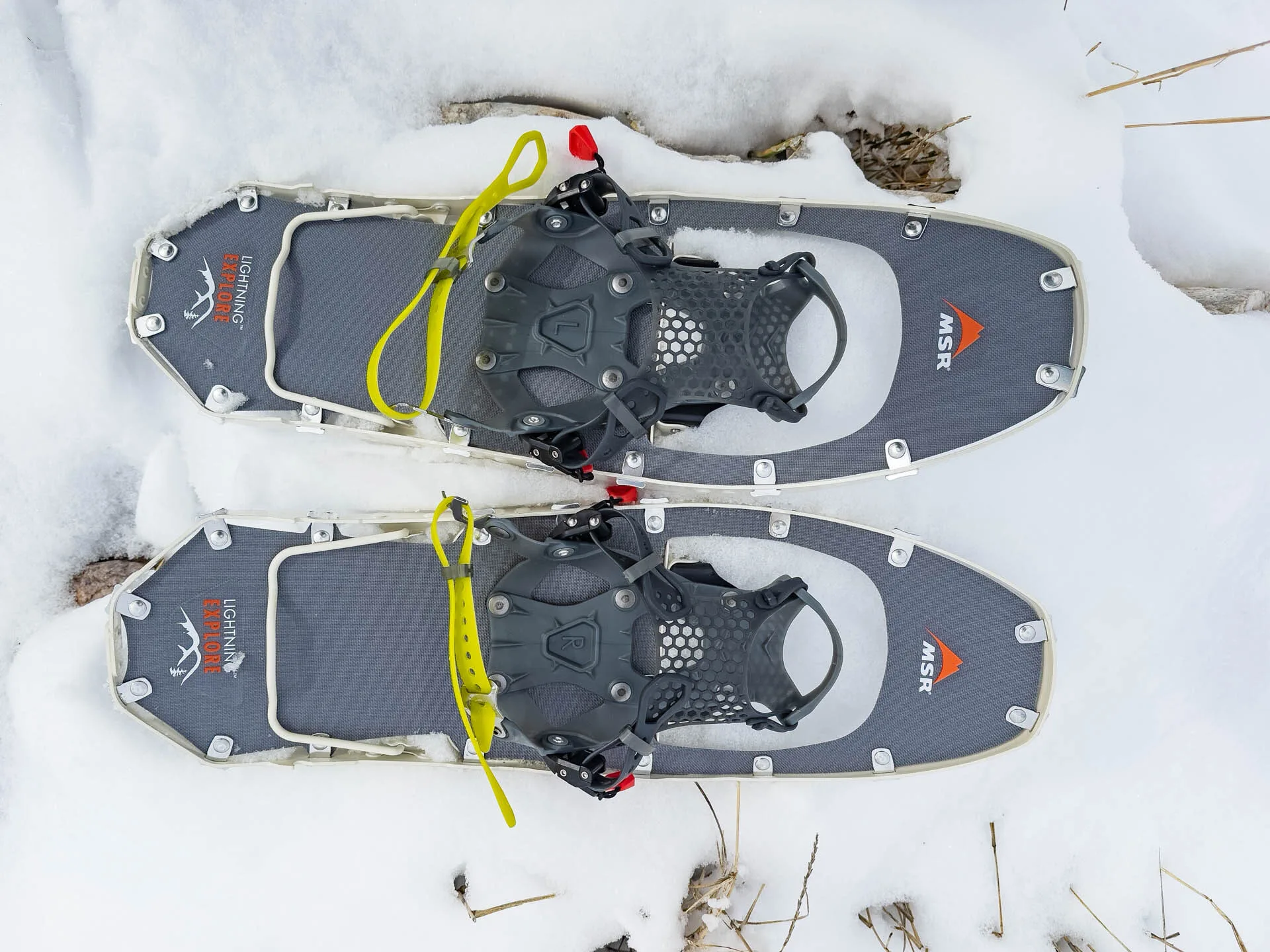
MSR Lightning Explore Snowshoes
These snowshoes also cost shiny new bindings for this year, which the brand has dubbed Paradigm Bindings. And yes, they’re comfy. They have three adjustment points and a toe stop, so your shoes will never inch forward over long downhill hikes. But they do have a touch of stretch, so your foot can still make some dynamic movements without feeling too locked into one position.
But our favorite feature may be the heel riser. Boy do we love a heel riser on steep climbs. It pops up easily and lifts your heel to take some of the strain off your calves, then flips back down again with a little push. And they’re attached to a sturdy all-steel frame, complete with crampons, and a nice, quiet nylon deck. And despite being constructed of more metal than the Evo Trail, these are a bit lighter.
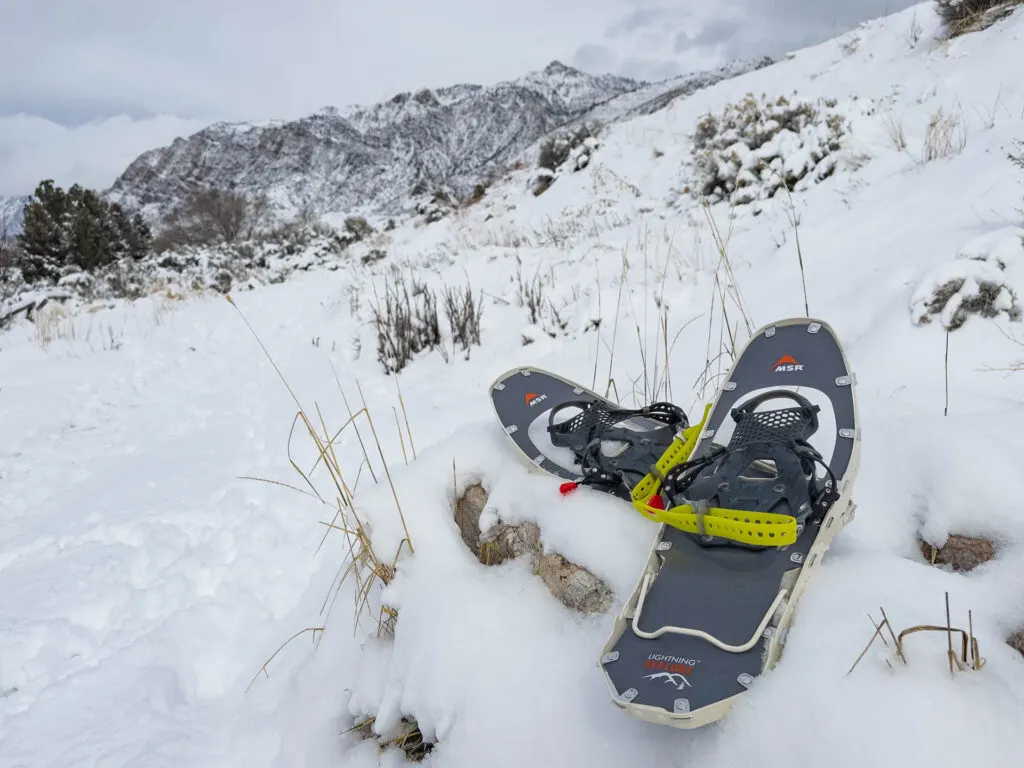
We even found them easy to adjust. Yup, even with gloves on. That’s because MSR puts nice chunky pulls on all the adjustment points (there are three) so they’re easy to grab and adjust on the fly. You simply pull the straps via finger loops to tight the straps that are attached to what MSR calls Roller Buckles, then yank on the large red tabs to easily loosen.
As for actual use, we were thrilled to discover how quiet these snowshoes are. A lot of snowshoes make loud clopping or snapping noises when your heel comes down and makes contact with the deck. That’s annoying at best and makes conversation (or enjoying the quiet reverie of nature in wintertime) impossible at worst. So the fact that these were some of the quietest we’ve ever tested immediately put them at the top of our favorites list.
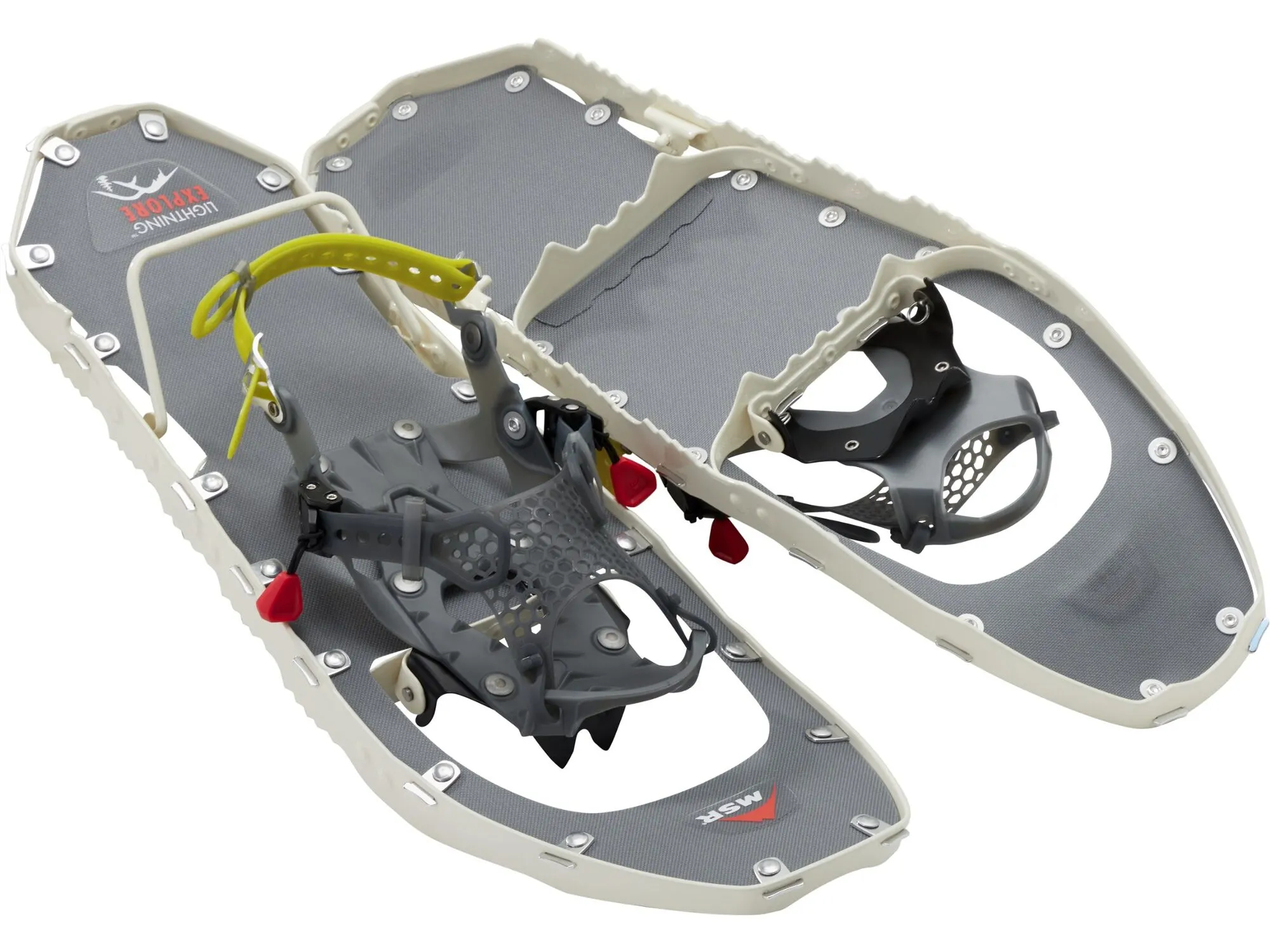
Do take note: These snowshoes are designed for intermediate to advanced snowshoers, i.e. folks getting out into winter terrain often and most likely tackling more challenging hikes than your average trail. And yes, they’re priced accordingly ($340!). So if you’re new to snowshoeing, know there are certainly other capable snowshoes for a lower price. But whether you’re new or experienced, if you want snowshoes that can seriously go the distance, these will do beautifully.
And that includes in deep snow. We didn’t test the tails that are available for purchase separately, but they’re a nice add-on if you plan to trek in serious powder where you might need a little more surface area to keep you on top of the snow. What’s more, these are available in both men’s and women’s sizes and in several lengths. The weight limit is 180 lbs for the 22″ model and up to 280 lbs for the men’s 30″. There’s a bit more weight wiggle room when you add on the flotation tails.
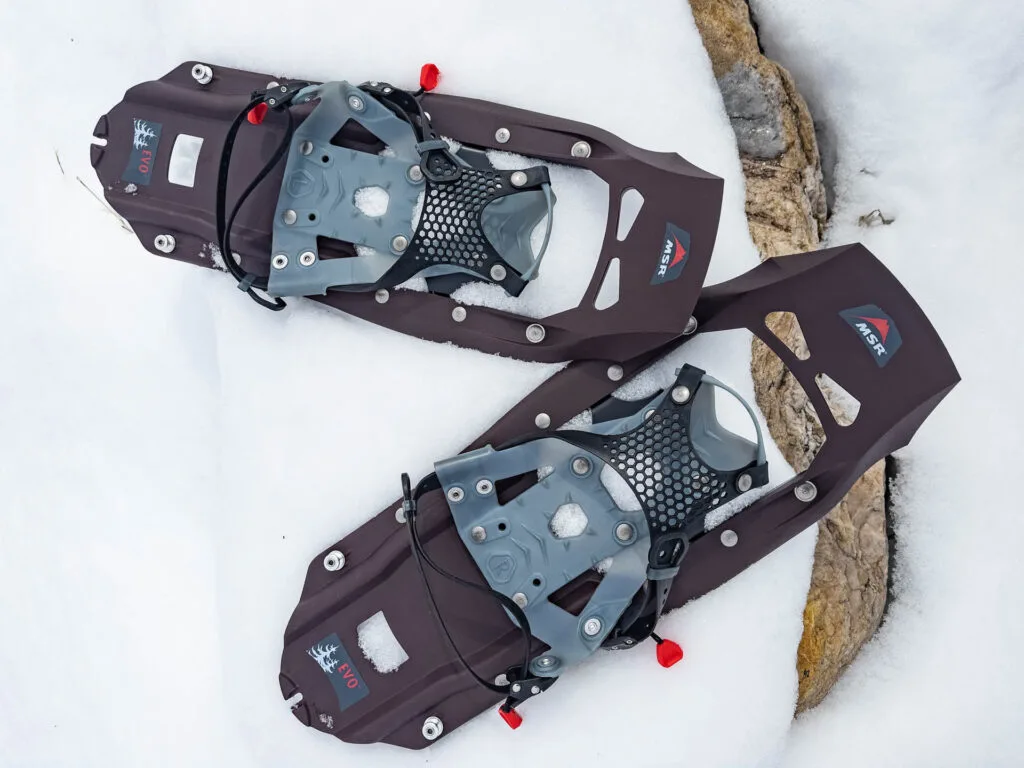
MSR Evo Trail Snowshoes
And yes, they’re priced significantly lower than the Lightning Explore at just $170. We know, that’s still not what most people (including us) would call a “budget buy,” but again, for those who snowshoe often, need a reliable, sturdy option, and want something that will last for years if not decades, this will do nicely and will likely be more than worth it in the long term.
The difference in price is due mostly to materials used: the Evo Trail has a fully plastic deck and frame with metal teeth attached to the bottom for good grip. They won’t offer quite as good traction on steep terrain simply because they don’t have extra crampons on the front, but we found them still more than sufficient for most hikes. And they don’t feature the same heel lift as the Lightning Explore, but for most hikes, honestly, we could do without. But you can still add on flotation tails (which are sold separately) to help keep you on top of especially deep or powdery snow.
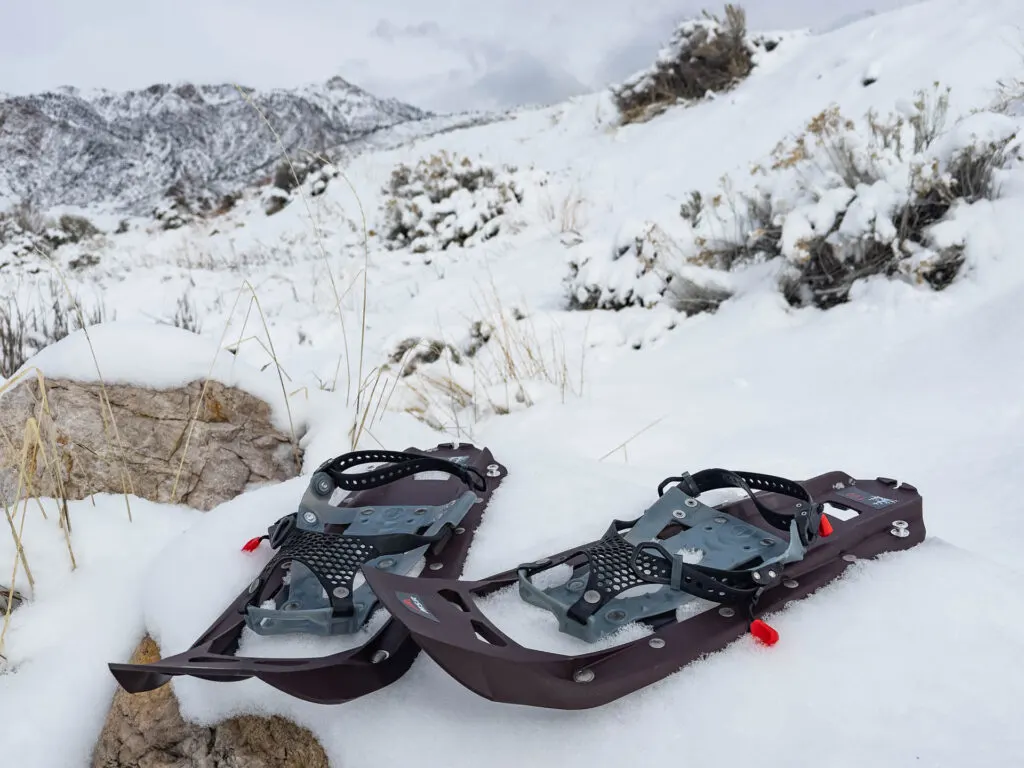
The Evo Trail features Paraglide bindings, which, honestly, are similar to the Paradigm bindings on the Lightning Explore, but only have two adjustment points. That did mean they were slightly faster to adjust, but were a bit harder to dial in a truly snug fit. Especially on smaller feet there were still some gaps we didn’t work too hard to eliminate but that didn’t seem to affect usability, either. On longer hikes it might make a minor difference. But they were still easy to adjust simply by pulling them to tighten (MSR calls them Roller Buckles) and tugging on the red tabs to loosen.
They are a bit clacky when walking. Not as loud as most other snowshoes we’ve tried, but enough to notice the difference between these and the Lightning Explore. We could still carry on a conversation, but whoever was wearing these had to listen a bit more closely to hear over the light tapping of their heels contacting the board.
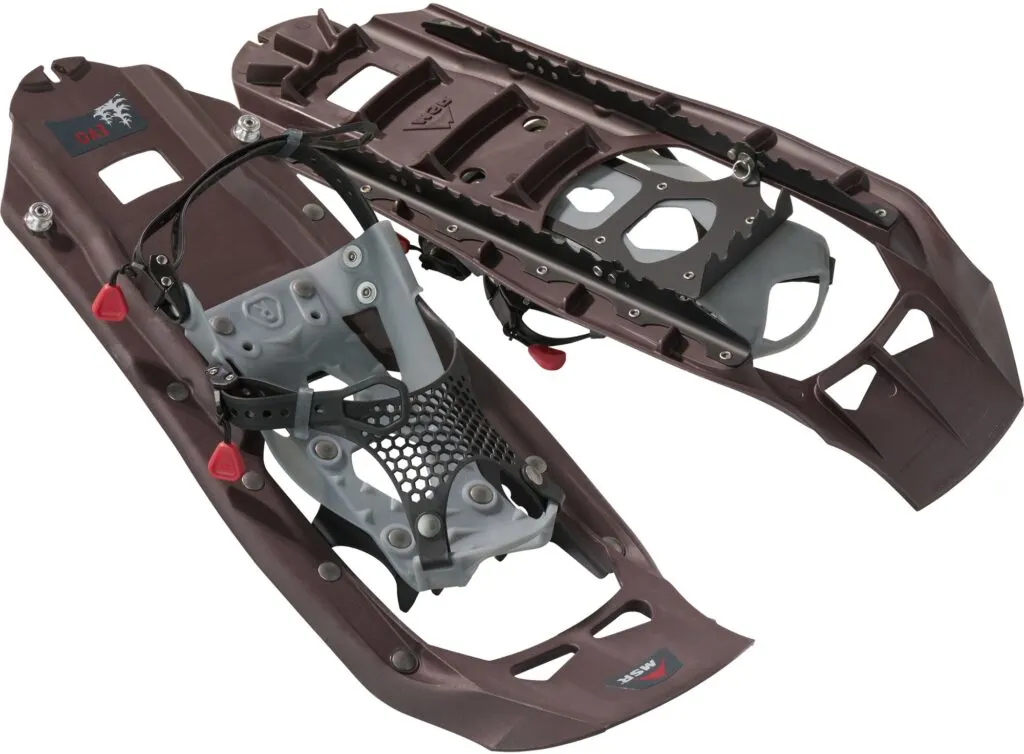
They did feel nice and light on our feet. Which is weird, because the Lightning Explore shoes are actually lighter. But something about the plastic frame made them feel more responsive and easily maneuverable. They also felt plenty grippy on moderate slopes and on ice despite having slightly less aggressive crampons. On extremely steep terrain we might watch our footing a bit more closely, but we had no problem hiking gentle sloping trails near us.
Unlike the Lightning Explore, these are only available in one unisex size and only one length: 22″. That does make them easy to order, though, and even easier to keep track of whose shoes are whose (it doesn’t matter; they’re all the same) if you’re buying a few pairs for the fam. Do take note: They are designed for a max load of 180 lbs, which includes whatever weight you might be carrying in a backpack. On the upside, if you add on a set of tails, that limit increases to 250 lbs.
Snowshoe Repairs
But one thing we dig about MSR snowshoes (besides the fact that parts of them are made in the USA–other parts in Ireland) is that they’re repairable. With many snowshoes, if something breaks, you’re out of luck; you have to toss the whole shoe and buy brand new ones. With MSR, just contact the brand’s warranty department and they’ll get the process rolling and help you send in your snowshoes, replace any broken parts, and then shoot them back to you in like-new condition. That saves you money in the long run (again, mostly if you use and abuse your snowshoes often on advanced terrain) and keeps crappier made gear out of landfills.
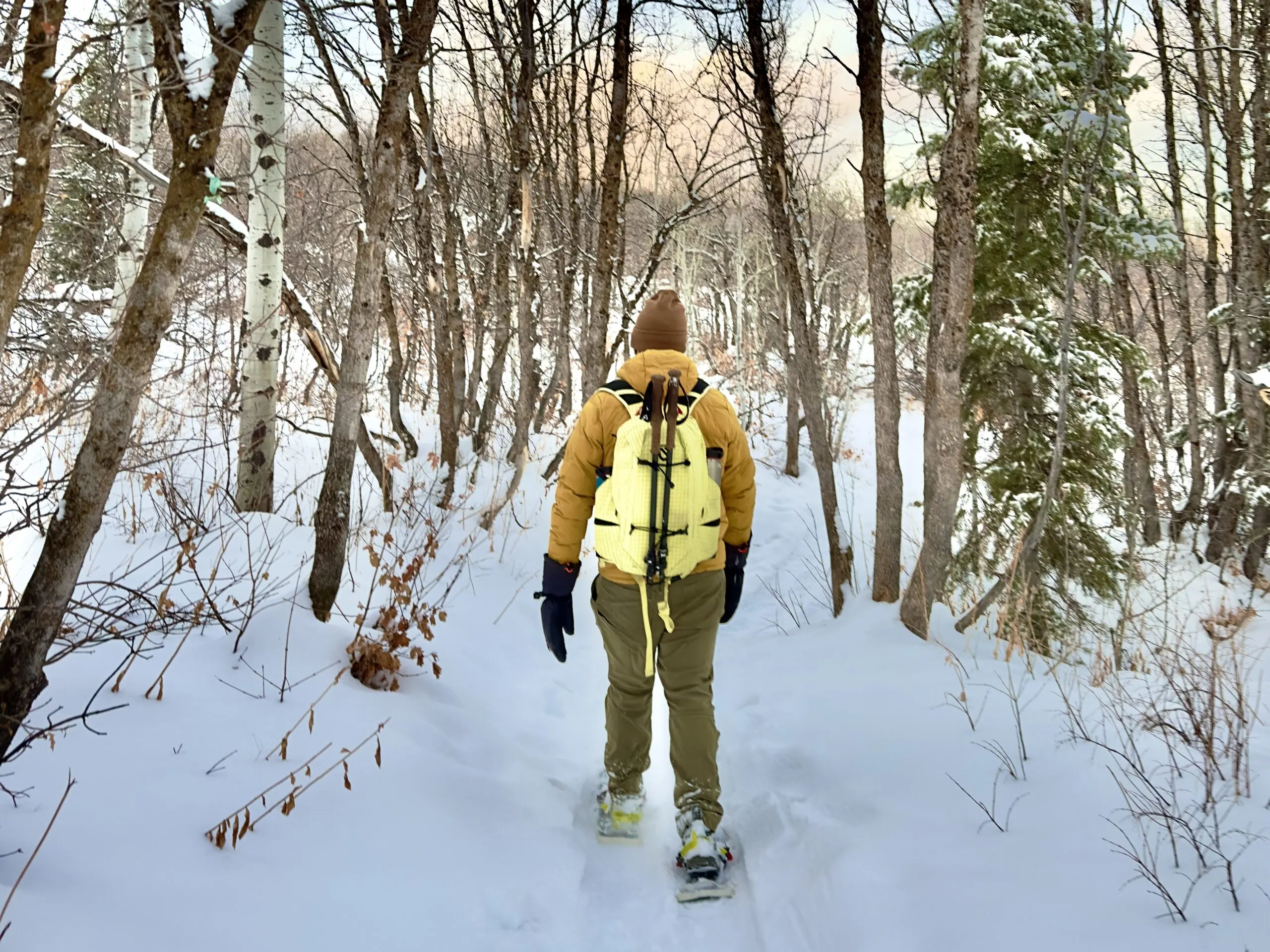
Bottom Line: Are Expensive Snowshoes Worth It?
But at this point, you’re probably wondering if paying out this much cash for a pair of snowshoes you’ll use for just a few months each year is worth it. That depends.
A more expensive snowshoe will typically be a higher quality snowshoe, meaning you’ll buy it once and not have to worry about buying any again for ages. That said, if you only snowshoe a couple times a winter, you’re probably not worried about burning through snowshoes, but it does offer some peace of mind to know if something does go wrong with a pair from a brand like MSR, you can get them fixed.
There’s also comfort to consider. A lot of cheaper models are big, clunky, heavy, and hard to walk in. Trust us; we’ve tried plenty. And chances are, the more expensive the snowshoe, the nicer and easier your hiking experience will be. Honestly, it should just feel a lot like walking with a little extra drag (bonus points if they’re also quiet).
More expensive shoes will also likely have better traction, which means longer teeth and crampons to dig into hard or icy snow. These can better keep you from sliding when you’re traversing a hill, especially, but also give you confidence in your footing when going down steep slopes.
But it comes down to you, your budget, and your preferences, so whatever shoes you choose, don’t let a little snow keep you from wandering on this winter.
Searching for more snowshoes? We also tested a few TSL snowshoes last winter!
